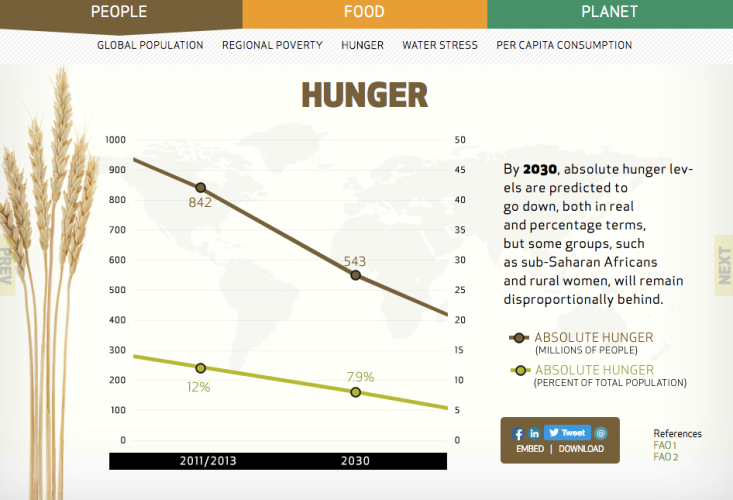Is the Sustainable Development Goal to End Hunger Achievable?
Ending hunger by 2030 is no small task. Ensuring everyone on our planet is well-fed and nourished is not only going to take greater quantities of food, but better quality food. Taking into account the rising temperatures, scarcity of water and perpetual conflict that persists in many parts of the world, it could seem like that SDG2 to end hunger may be out of reach.
But we only need to look at the remarkable progress that has been made in recent years to realise that ending hunger is, slowly but surely, becoming a reality. The number of hungry people has gone down by 167 million over the last decade. According to FAO, we are on track to reduce hunger to just 7.9% of the global population by 2030. By stepping up our efforts now, we can reduce that percentage to where it should be: zero.
 |
At Farming First, we believe that innovations and investments in agriculture are going to be critical to ending hunger. To demonstrate exactly how, we have been breaking down each of the five targets of Sustainable Development Goal Two to find out exactly how agriculture is helping organisations all over the world make progress to this vital goal. Over five weeks, our “SDG2 Countdown” has tested your knowledge on each target with a weekly quiz, produced an infographic of fast facts and brought you a brand new video series, “SDG2 in 2 Minutes”. Here are some of the fantastic things we have learnt.
SDG2.5: Protecting genetic diversity
Genetic diversity are all the varieties of plant and animal species that exist, either in a natural environment or preserved in a genebank. We need them because they all have unique traits that could help us breed a crop or animal resistant to a current or future threat. This could be a new pest or disease, or even a war that wipes out seed supplies. Farmers have been using different species to grow resilient crops for many decades, and in recent years, plant breeders have been making breakthroughs using genes preserved in genebanks. Krysta Harden, Chief Sustainability Officer at DuPont, recently visited the largest genebank in the world – the Svalbard Global Seed Vault in Norway. Hear her explain at this link in two minutes why it is such an important asset for ending hunger.
SDG2.4: Resilient food systems
The fourth target for SDG2 encourages us to build food systems that are more resilient. This can mean that they are well adapted to climate change, or that they can overcome a sudden shock, like a food price spike. Rhiannan Price at our supporter organisation, Digital Globe, spoke to us about the crucial role that satellite imagery can play in building resilience in remote rural areas. How? It allows us a lens into areas we wouldn’t normally have access to and helps us monitor the health of agriculture systems. It can target interventions more effectively and help us monitor progress. Watch her SDG2 in 2 Minutes video here.
SDG2.3: Doubling productivity and smallholder incomes
This may seem like a straightforward target – but as Margaret Ziegler of the Global Harvest Initiative explained to us, productivity isn’t just about increasing yields. It’s about managing to produce more with less. By investing in agricultural research and extension to train smallholder farmers on how to produce more while using less land, water and other finite resources, we will stand a much better change of meeting SDG2.3. Other experts told us that getting financing to smallholders, so they can invest in their business in order to grow, and improving access to vital inputs such as seeds and fertilizer will also be key. Watch Margaret’s video here.
SDG2.2: Ending malnutrition
“Agriculture is where it all starts,” explained Roger Thurow when we interviewed him on SDG2.2. In his new book, The First 1,000 Days, he tracked the nutrition of children in different parts of the world, from conception to their second birthday. The most common craving the expectant mothers had? The knowledge to keep their baby healthy. And in the developing world, this can mean feeding them nutritious foods that are biofortified with extra micronutrients, like high iron beans. Ending malnutrition isn’t just good for the health of populations either, he explained, but for economies too. Developing countries in particular lose vast percentages of their GDP due to lack of nutrition. So investing in ending malnutrition pays off, literally. Watch the full video here.
SDG2.1: Ending hunger
The final target, the main event. In our conversation with Gilbert F. Houngbo, President of the International Agricultural Fund for Development, he underlined why ending hunger will begin with investing in rural farmers. So many of the world’s poorest rely on agriculture for their livelihoods. The more we invest in smallholder farmers, the more we contribute to inclusive economic growth. Watch his full interview for “SDG2 in 2 Minutes” here.
These past five weeks we have gathered vast amounts of evidence that organisations all over the world are making incredible progress to end hunger. Explore all the quizzes, videos, infographics and blog posts at farmingfirst.org/SDGs, and share your own SDG2 success stories with us, by using #Ag4SDGs.


